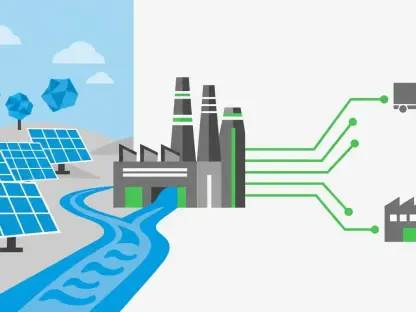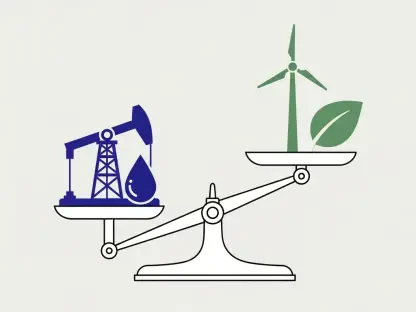Amidst the rapid evolution of technology, one of the most profound shifts is the increasing reliance on artificial intelligence, especially within data centers. With the capability to process and sift through immense amounts of data, AI is now essential in our increasingly digital age. However, this surge in AI application comes with a critical challenge: the soaring energy demands associated with its deployment. With the daily generation of around 400 million terabytes of data worldwide, the need for robust data centers has intensified, placing significant pressure on global power resources.
Growing Energy Needs in Data Centers
The Role of Artificial Intelligence in Data Processing
Artificial intelligence has emerged as a pivotal tool in managing and processing massive data volumes produced every day. Its prowess lies in its ability to streamline data retrieval processes across various sectors. However, this capability comes at a cost: increased energy requirements. Data centers, the backbone of this AI-driven ecosystem, consume significant electricity, a trend that experts predict will continue growing. According to the International Energy Agency (IEA), an average data center uses between 5 and 10 megawatts, while hyperscale centers may surpass 100 megawatts in demand. This has been a cause for concern, as these energy needs already accounted for about 1% of the world’s consumption in 2024. By the end of the decade, this figure may reach nearly 10% in key regions like the U.S., China, and Europe.
At the heart of this transformation are leading institutions like Los Alamos and Sandia National Labs, which play a crucial role in furthering AI research. These labs, along with other tech behemoths, are continually advancing AI technologies, emphasizing the necessity for energy-efficient solutions. While AI offers numerous advantages, reducing redundant processes in data management, the overarching challenge remains: how to balance its growth with sustainable energy usage.
Hyperscale Data Centers and Their Energy Impact
The emergence of hyperscale data centers is a direct response to the unrelenting demand for data processing capabilities. These massive facilities are equipped to handle vast amounts of data, providing essential services to major corporations. As businesses expand their AI-driven operations, these centers have increasingly become the norm. Yet, their colossal size and processing power translate into substantial energy consumption. Hyperscale data centers are estimated to require over 100 megawatts, pushing them to the forefront of energy consumption debates.
Despite their energy-intensive nature, these centers offer opportunities for more efficient data processing methods. By centralizing information and streamlining operations, hyperscale centers can, in the long term, lead to fewer resource redundancies. This centralized approach might offset some electricity consumption, reducing overall grid strain. However, tackling the challenges of increased energy demand remains crucial, where innovative solutions in energy management and renewable resource integration hold promise in optimizing these powerful data hubs.
The Energy Cost of AI-Enhanced Queries
Understanding the Energy Dynamics of AI Web Searches
One often-overlooked aspect of AI’s energy use involves the electricity consumed during AI-enhanced web queries. Insights from Goldman Sachs indicate that these types of searches may require ten times more energy than traditional internet searches. However, what initially appears as a drawback could be a blessing in disguise. The sophisticated nature of AI-enhanced searches improves data retrieval efficiency, consolidating multiple search actions into single, more effective attempts. This efficiency means that while an individual AI search might consume more energy, the overall search frequency is reduced, leading to a net saving over time.
By streamlining searches, AI systems minimize redundancies and optimize information-gathering processes, translating into strategic advantages for enterprises seeking precision. Organizations can leverage these improvements to make more informed decisions quickly, offsetting some of the energy costs associated with AI technology. While the immediate energy footprint appears daunting, the long-term gains suggest a compelling case for embracing AI-enhanced search capabilities in day-to-day operations.
Balancing Energy Costs and Productivity
The discussion about balancing the immediate energy costs of AI-enhanced searches with the productivity improvements they offer remains salient. Enhanced search tools empower users with faster, more accurate information retrieval, reducing the need for repetitive actions often associated with conventional search methods. This reduction in redundancy not only enhances efficiency but also offers significant energy-saving potential, contributing to a more sustainable technological environment.
Efforts are underway to integrate energy-efficient algorithms, ensuring that the additional power requirements associated with AI searches are balanced by substantial gains in efficiency. By focusing on optimizing algorithms and enhancing hardware frameworks, industries are paving the way toward AI applications with minimal energy costs. As technology continues evolving, the focus on creating AI-driven systems with manageable power demands remains a top priority, ensuring a sustainable balance between power consumption and AI-enabled productivity.
Balancing AI’s Promise and Energy Requirements
Optimizing AI for Sustainable Growth
In addressing AI’s growing energy demands, the challenge lies in harnessing its benefits while minimizing its environmental impact. Data centers, in particular, play a pivotal role in this endeavor. Optimizing AI integration means not only refining its deployment strategies but also investing in energy-efficient technologies. As AI continues revolutionizing how data is processed and leveraged, stakeholder collaboration will be essential in developing innovative solutions that balance progress with sustainability. Promoting clean energy sources and adopting more efficient cooling mechanisms are vital steps to reduce the carbon footprint of data centers. By prioritizing eco-friendly practices, the tech industry can set benchmarks for sustainable growth while ensuring AI remains a viable and powerful tool across sectors.
Future Considerations in Energy Management
In the fast-paced world of technology, one of the most transformative changes is the growing dependence on artificial intelligence, particularly in the realm of data centers. AI’s ability to process and analyze vast amounts of information has become indispensable in our digital era. Nonetheless, this widespread use of AI presents a major concern: the escalating energy requirements tied to its operation. AI needs substantial computational power, and as such, demands for energy have surged. Each day, approximately 400 million terabytes of data are created globally, intensifying the demand for efficient data centers which, in turn, exert significant strain on worldwide energy supplies. These data centers must not only handle huge volumes of data but also adapt to the ever-increasing speed at which data is generated. This scenario creates a pressing need for sustainable solutions to manage both the energy consumption and environmental impact of our data-driven future.









